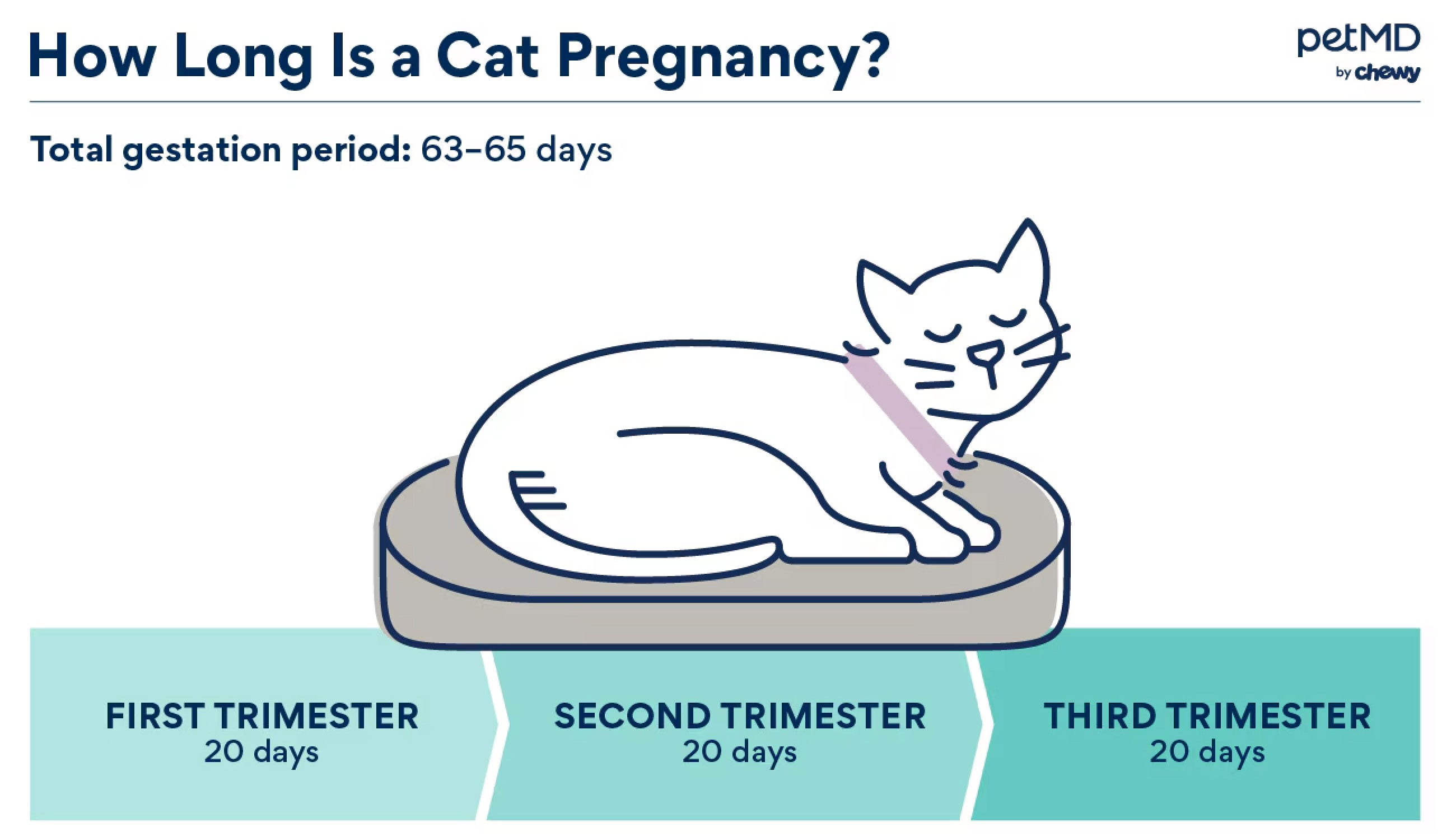Are you curious about How Long Are Cats Pregnancy and the journey to kittenhood? At solcat.net, we understand the excitement and anticipation that comes with expecting a litter of kittens. We’re here to provide a friendly and persuasive guide, packed with valuable information and tips to help you navigate this special time.
1. Understanding Cat Pregnancy Duration
How long is a cat pregnant? The average gestation period for cats is approximately 63 to 65 days, or about two months. This period can be divided into three trimesters, each lasting around 20 days. However, it’s often challenging to distinguish between the first two trimesters without veterinary assistance.
The gestation period is influenced by several factors, including:
- Breed: Certain breeds may have slightly shorter or longer pregnancies.
- Litter Size: Larger litters might result in a slightly shorter gestation.
- Individual Variation: Just like humans, cats can experience variations in pregnancy length.
 Pregnant cat belly
Pregnant cat belly
2. Recognizing the Signs of Feline Pregnancy
What are the early signs of cat pregnancy? Spotting the signs of pregnancy in your cat can be tricky, especially in the early stages. Keep an eye out for these indicators:
- Nipple Changes (Pinking Up): Around 16-20 days into pregnancy, the nipples become more prominent and pinker.
- Increased Appetite: Pregnant cats often eat more to support their growing kittens.
- Morning Sickness: Some cats may experience vomiting, similar to morning sickness in humans.
- Behavioral Changes: Your cat might become more affectionate, docile, or seek more attention.
- Abdominal Enlargement: The belly will start to swell noticeably in the later stages of pregnancy.
- Nesting Behavior: As she nears her due date, your cat will start looking for a safe, quiet place to give birth.
3. Navigating the Three Trimesters of Cat Pregnancy
What happens during each trimester of a cat’s pregnancy? A cat’s pregnancy is divided into three trimesters, each with its own set of changes and developments:
3.1. First Trimester (Days 1-21)
During the first trimester, you might notice subtle changes in your cat’s appetite and the “pinking up” of her nipples. However, most pet parents observe little to no visible changes during this period.
3.2. Second Trimester (Days 21-42)
The second trimester brings more noticeable physical signs. Your cat’s belly will start to enlarge, and she may exhibit behavioral changes, such as becoming calmer and more affectionate.
3.3. Third Trimester (Days 42-63)
Pregnancy changes become more significant in the final trimester. Your cat’s belly will swell considerably, and you’ll notice increased nipple and breast changes. She may develop a voracious appetite, frequently groom her belly and vulva, and start nesting in preparation for her kittens’ arrival.
4. Determining How Far Along Your Cat Is
How can you tell how far along a pregnant cat is? Determining your cat’s due date can be challenging unless she was intentionally bred. Veterinarians can use various methods to estimate the stage of pregnancy:
- Palpation: A vet might be able to feel the fetuses around two and a half weeks into the pregnancy.
- Ultrasound: Kitten heartbeats can be detected via ultrasound at three to four weeks.
- X-Ray: Kittens become visible on an X-ray once their skeletons calcify, around six weeks.
These milestones, combined with observing your cat’s physical and behavioral changes, can help you estimate how far along she is.
5. Providing Optimal Care for a Pregnant Queen
What special care do pregnant cats need? A pregnant cat requires special care to ensure a healthy pregnancy and birth. Here’s what you need to know:
5.1. Creating a Comfortable Environment
Provide your pregnant cat with a quiet, comfortable spot in your home. This should include a cardboard box or covered bed lined with soft blankets, towels, or old sheets. The bed should be secluded but easily observable to ensure the birth is progressing safely.
5.2. Nutrition for a Pregnant Cat
What is the best diet for a pregnant cat? Pregnant cats need a high-calorie diet to support the growth of healthy kittens. Feed her a commercial cat diet specifically labeled for pregnancy and lactation or for kittens (growth).
Transition your cat to this high-calorie diet by the end of the first month of pregnancy. Continue feeding her this diet until weaning, when the kittens are no longer nursing. Pregnant queens should receive frequent meals throughout the day.
5.3. Vaccinations and Pregnancy
Should pregnant cats be vaccinated? Ideally, cats should be vaccinated before pregnancy to prevent illnesses, birth defects, and pregnancy loss due to infectious diseases. Vaccinated queens also pass on protection to their kittens through nursing.
If your cat wasn’t vaccinated before pregnancy, it’s best to wait until after she gives birth. Live vaccines should never be given to pregnant animals, but killed vaccines can be administered if your vet deems it appropriate.
5.4. Parasite Prevention
Is parasite prevention safe for pregnant cats? Parasite prevention can continue during pregnancy, but it’s crucial to use safe products. Consult your veterinarian about suitable options for your pregnant cat. It’s also wise to have a fecal sample checked for worms, as some intestinal worms can pass from mother to kittens during pregnancy and nursing.
5.5. Recognizing Illness in Pregnant Cats
Cats are skilled at hiding illness, so it’s crucial to monitor your pregnant cat for any subtle signs of discomfort. If she stops eating, experiences diarrhea or vomiting, or shows other unusual symptoms, consult your veterinarian immediately.
Vaginal discharge, especially blood, is not normal at any stage of gestation. Seek urgent veterinary care if this occurs.
6. Preparing for Labor and Delivery: A Step-by-Step Guide
How do you prepare for a cat’s labor and delivery? As your cat enters her last trimester, prepare a designated nesting area for her. Cats prefer a quiet, private space to give birth. A cardboard box lined with soft materials makes an ideal birthing nest.
6.1. Recognizing the Signs of Labor
Be aware of the signs of labor in your pregnant cat. Most queens will stop eating the day before labor begins and may exhibit agitated scratching at their chosen nesting spot. A drop in rectal temperature below 100°F indicates that labor will start within the day.
6.2. The Stages of Labor
Labor occurs in three stages:
- Stage 1: Contractions begin but are not visibly noticeable.
- Stage 2: The cat shows active signs of straining as the kitten passes through the pelvis. This stage usually takes 5-30 minutes per kitten.
- Stage 3: The fetal membranes and placenta are passed for each kitten.
It’s normal for queens to eat these membranes.
6.3. Monitoring Labor
Monitor your cat during labor, but avoid interfering unless there are signs of a complicated birth. Contact a veterinarian if your cat has visible contractions for more than 20 minutes without producing a kitten, or if it takes longer than 10 minutes to pass a kitten visible in the birth canal.
Cats can pause labor between kittens for up to 24-36 hours, especially if they feel unsafe. Most cats deliver all their kittens within six hours.
7. Providing Postpartum Care for the New Mother Cat
What care does a cat need after giving birth? Once all the kittens have been born, ensure they are dry and their noses and mouths are clear. Clean any soiled linen in the nesting box and maintain a temperature of 85-90°F for the first week.
Monitor the mother cat to ensure she’s allowing normal nursing behaviors. If you’re concerned that she’s rejecting her kittens, seek veterinary advice.
8. Common Questions About Cat Pregnancy: FAQs
Have questions about cat pregnancy? Here are some frequently asked questions:
8.1. At what age can a cat get pregnant?
Cats can get pregnant as young as four months old, but pregnancy is more common at 5-6 months.
8.2. How long does it take for a cat to give birth?
Cats are pregnant for 63–65 days, and the entire birthing process usually takes place within six hours.
8.3. What does a pregnant cat look like?
A pregnant cat will develop an enlarged abdomen, and her nipples may become darker and enlarged.
8.4. Can a cat get pregnant while nursing?
Yes, cats can get pregnant while nursing, as they come into heat multiple times a year.
8.5. What if my cat doesn’t seem to be producing enough milk?
Consult your veterinarian. They can assess the situation and recommend appropriate interventions, such as supplemental feeding for the kittens.
8.6. How often should the kittens be nursing?
Newborn kittens should nurse frequently, approximately every 2-3 hours.
8.7. What are the signs of a healthy newborn kitten?
Healthy kittens are active, gain weight steadily, and nurse regularly.
8.8. When do kittens start to open their eyes?
Kittens typically open their eyes around 1-2 weeks of age.
8.9. When should kittens be weaned?
Weaning usually begins around 4 weeks of age and is completed by 6-8 weeks.
8.10. What vaccinations do kittens need?
Kittens need a series of vaccinations, typically starting at 6-8 weeks of age. Consult your veterinarian for a vaccination schedule.
9. Stay Informed and Connected at solcat.net
At solcat.net, we’re dedicated to providing you with the most up-to-date and reliable information on cat care. Whether you’re a seasoned cat owner or a first-time pet parent, we have the resources you need to ensure your feline friend lives a happy, healthy life.
9.1. Expert Articles
Our team of experienced writers and veterinarians create informative articles on a wide range of topics, including nutrition, behavior, health, and more.
9.2. Engaging Community
Connect with other cat lovers in our active online community. Share your experiences, ask questions, and get support from fellow cat enthusiasts.
9.3. Latest Research
Stay informed about the latest scientific findings and advancements in feline care. We provide summaries of relevant research studies to help you make informed decisions about your cat’s well-being.
10. Unleash Your Inner Cat Expert with solcat.net
Ready to dive deeper into the fascinating world of cats? Visit solcat.net today and discover a wealth of information and resources.
- Address: 950 Alaskan Way, Seattle, WA 98104, United States
- Phone: +1 (206) 386-4000
- Website: solcat.net
At solcat.net, we’re passionate about cats, and we’re committed to providing you with the tools you need to be the best cat parent possible.
11. Explore Additional Resources
- Cornell Feline Health Center: A trusted source of information on feline health.
- American Animal Hospital Association (AAHA): Offers resources on pet care and veterinary services.
By partnering with solcat.net and leveraging these valuable resources, you can confidently navigate the exciting journey of cat pregnancy and kittenhood!

